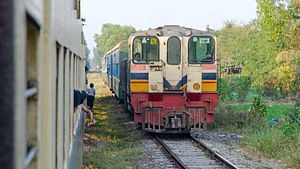Myanmar’s railway system is perhaps the last historical relic that anyone is lining up to save. While the moldy facades of colonial buildings are receiving makeovers with bright new coats of paint, any change that comes to this dilapidated rail system will likely be as slow as the train cars that jostle people and freight up and down its ancient rails.
In clear contrast to the gold-rush euphoria seen in other sectors, foreign investment will be unlikely to fix the railways until after 2020. With Myanmar opening up to Western investment in 2011, a widening chasm has already begun to separate the pace of growth in banking, telecommunications and construction from that of public transportation and infrastructure. It’s a clear sign of the road ahead: booming commerce juxtaposed against precarious and often risky public infrastructure.
Southeast Asia is a region not unfamiliar with poor urban planning yet unbridled economic development (think Manila and Jakarta). Myanmar appears to settling for a similar track.
“The ride is long, the windows are old, the seats are bad, there is no working fan, and the toilets have no lights,” U Kyaw Sin, a male passenger traveling with family members – two women and a young boy – told me during a recent journey on the Myanmar railway from Yangon to Taunggyi, the capital of Shan State.
Altogether, the journey took 33 hours, including an overnight stay at a station. During the water festival, Myanmar’s new year, water of suspect provenance is tossed into the cars throughout the day, soaking those who aren’t quick enough to close the rickety windows.
The daylight hours of the trip are overwhelmed with the density of bodies. With his upper class ticket, U Kyaw Sin is fortunate enough to have a seat. With money flowing into Yangon, train fares have been rising together with the prices of other staples, even as Myanmar’s per capita income remains around $1,144, higher only than Cambodia in Southeast Asia, according to KPMG. If the touted economic prosperity means higher costs with stagnant wages, then many of the passengers on this train would seem to be better off without it.
A vestige of British colonial days, the Myanmar Railways began with a line from Yangon to Pyay (formerly Prome) built in 1877, with extensions to what would become the Yangon-Mandalay line beginning seven years later. These steel rails have not been properly maintained since the British left after WWII, leaving warped and offset tracks that restrict speed to about 25 mph and torment passengers with backbreaking jolts strong enough to send full-grown men several inches airborne.
Stewardship of these rails is now once again set to pass into the hands of a foreign power. Japan has committed about $194 million to upgrading the system. It expects to dispatch experts to begin fieldwork by 2016, with work scheduled to be completed sometime after 2020.
“We will start to work on railroads between January and October, 2016. It will continue for the next four years until September 2020. The monitoring period for the project will be between 2020 and 2022,” local media quoted Than Htay, Myanmar’s Minister of Rail Transportation, as saying.
Yet Myanmar can move with surprising speed on public infrastructure projects, especially when they have direct repercussions for the revenues of the quasi-civilian government. Inertia can be overcome, helped by a nudge from above, and the work carried out quickly, if haphazardly.
Take the Yangon-Mandalay Highway, which runs parallel to the Yangon-Mandalay rail line. Initiated by the military regime in 2006, the highway links the country’ two largest cities together with Naypyidaw, its secluded capital. Open to traffic in 2011, the 366-mile road has since earned the moniker “Highway of Death” due to the very high rate of fatalities, a result of rushed drivers speeding along lanes built by rushed engineers. The latest tragedy occurred on May 12 when a bus overturned while trying to overtake a car at high speed, killing 14 people and seriously injuring 29. Highway police say that no fewer than 110 people have been killed in accidents on this road in the past year alone.
Myanmar is a spiritual place just beginning to establish a grasp of the modern commercial world, so the natural reaction to the latest deaths has been to purge the crash site of evil spirits and set up new insurance policies, now offered by 12 separate firms, including the government-backed Myanma Insurance.
But for U Kyaw Sin and his family, sweating it out on the train may remain – for the foreseeable future at least – a more attractive option than speeding over spirits trapped in an unfinished road.
Justin Calderon is a freelance journalist based in Yangon, Myanmar, and his work has appeared in CNN, Newsweek, Global Post and the Nation (Bangkok).

































